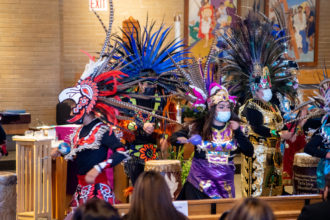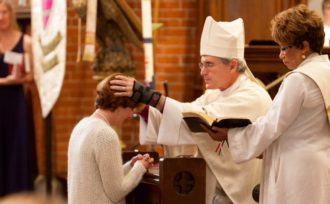If the founders of St. Matthias Episcopal Church were alive today, there’s a good chance they wouldn’t know what to make of the current congregation.
Believed to be home to the oldest historically African American congregation in Asheville, St. Matthias’ original building was built in 1867 in the immediate aftermath of the Civil War. The church housed a parochial day school for Black children and adults and served as a hub for religious and community life.
But congregations ebb and flow. Members grow old, children grow up, and neighborhoods change. St. Matthias is no different, explains church treasurer Bill Mance, a member since 2003. Over the years, he’s watched the congregation diversify, a trend reflected in the tagline on St. Matthias’ website: “Inclusive and multicultural.”
Today, roughly half of St. Matthias’ 80 members are Black, the other half are white. Some are new to the area; others have lived in Asheville their whole lives. And through worship and involvement with the St. Matthias community, all are keenly aware of issues surrounding race.
“We have discussions about race routinely,” says Mance, who is Black. “The whites aren’t afraid to talk about it, and of course the African Americans aren’t afraid to talk about it. It gets included in Sunday school and church services.”
St. Matthias is the “gold standard” of racially integrated churches in the area, says the Rev. Brian Combs, pastor at the Haywood Street Congregation. As congregations across the region grapple with shifting demographics and a year of racial upheaval, multiracial congregations find themselves tackling tough conversations in the way they know best: worship and fellowship.
“This is what we feel is intended when we talk about community,” Mance says. “It should be diverse, because Christianity speaks of being there for everybody. And we live that.”
A new normal
The Rev. Martin Luther King, Jr. famously called 11 a.m. Sunday “the most segregated hour in Christian America.” But the past 20 years have seen an uptick in multicultural congregations, explains Mark Chaves, a professor of sociology and religious studies at Duke University’s Divinity School. Chaves directs the National Congregations Study, a survey of religious groups conducted every few years.
The NCS defines a multiracial church as having no one racial or ethnic group constitute more than 80% of congregants. Last year, researchers found multiracial congregations had increased from 6% of all U.S. churches in 1998 to 16% in 2019; over the same period, the percentage of all worshippers participating in multiracial congregations jumped from 13% to 24%.
Across denominations, the study found that Catholic congregations were the most diverse, followed by evangelical Protestant, Pentecostal protestant and mainline Protestant congregations. Chaves suggests that the most important change has been a drop in all-white congregations, from 19% in 1998 to just 6% in 2019.
“This trend sometimes goes under the radar because people think that a handful of African American or Latino families doesn’t really alter the culture of the church,” he says. “I’m not so sure about that. I think that even some minority presence goes a long way to changing the culture.”
The shift may be partly driven by increased upward social mobility among African Americans, who may be drawn to the shorter worship services and different style commonly found among predominantly white, liberal churches, Chaves speculates. These congregations may appeal to LGBTQ people of color who may not feel welcome in more traditional spaces, he notes. Increasing political polarization may also drive some congregants of color to churches that mirror their stances on social and racial justice.
But the big unanswered question, Chaves adds, is whether increased diversity in worship will help heal or further exacerbate racial inequalities.
“It’s not just about achieving some diversity: It’s about what to do with it once it’s there,” he says. “How does diversity affect the life of the church and the people in it? Are they breaking down racial barriers inside these churches or are they redirecting them in some way?”
Forging an identity
On a Sunday morning three weeks out from Christmas, St. Eugene Catholic Church in North Asheville celebrated the Feast of Our Lady of Guadalupe, a day of celebration for the Hispanic Catholic community. Aztec dancers, wearing ornate ceremonial dresses and brightly colored headpieces, twirled to the beat of drums in front of the altar. As the music faded, Mass began — in Spanish.

The congregation at St. Eugene has identified as multiracial for the last 25 years, explains the Rev. Pat Cahill, the church’s pastor. On any given Sunday, roughly a third of attendees identify as Hispanic, he says, with congregants hailing from Mexico, Venezuela, El Salvador, Colombia, Peru, the Dominican Republic and Guatemala.
To Cahill, the church’s multiracial identity spans more than just having members of diverse ethnic backgrounds. Sunday Mass is offered in English and in Spanish, and he incorporates readings in Tagalog and Creole to celebrate the traditions of Filipino and Haitian attendees. He helps organize retreats and cultural festivals for the region’s Hispanic population, and he says he’s called out members who made offensive comments about members of color. “We want everyone to feel represented in the tapestry that makes up our church,” he says.
To keep power and privilege out of worship, Combs uses a participatory service style at the Haywood Street Congregation. The United Methodist Mission congregation keeps no formal membership roll and seeks to “welcome the most unwelcome people in the world,” whoever they may be. He estimates the congregation’s demographic breakdown falls roughly 80% white, 20% Black.
Church leaders make a point to invite people without housing to choose music, serve Communion, read sacred texts and offer the benediction. In the middle of the sermon, congregants of all backgrounds are invited up to speak. “We’re trying to do something intentionally different about the hierarchy by making an attempt to invert it,” Combs says.
And at St. Matthias, Mance points to the music selected during services as a way the church connects with members of all backgrounds. In addition to the hymnal used across the Episcopal Church, St. Matthias routinely uses a second songbook, Lift Every Voice, with hymns that draw on African American culture and history.
One-way street?
But representation of cultural traditions within worship services only goes so far. To build multiracial congregations, some people must be willing to move into spaces where they’re in the minority. More often than not, this movement only goes one way, Chaves says: People of color tend to visit predominantly white churches, but whites tend to stay away from predominantly nonwhite churches and services.
Despite Cahill’s best attempts, the priest sees that phenomenon working at St. Eugene. It’s rare to see white congregants attend a Spanish Mass, he notes, although Spanish speakers often attend services in English. He attributes much of this to the language barrier: Even though Catholic services are “very predictable,” he sees congregants gravitate to services where they understand most of what’s being said. Most Spanish-speaking congregants know at least some English, Cahill says, and those who don’t often have bilingual school-age children to help translate.
In the 31 years the Rev. John Grant has served as pastor at Mount Zion Missionary Baptist Church on Eagle Street, only four white members have joined the historically African American congregation. Mount Zion has always participated in interracial fellowship with other Asheville churches, Grant says, but after the “kumbaya and Jesus loves you” moments, the respective congregants go back to their default mode of separateness.
Grant attributes some of this split to the human tendency to gravitate toward people who mirror one another physically and culturally. Racial divides are deeply ingrained into the psyche of American religion, he adds, and aren’t easy to overcome.
“As a congregation, we want diversity,” he says. “Of course, that means not just people coming to African American churches, but it can also mean members of African American churches going to predominantly white congregations. It goes both ways, this diversity thing, and to get really serious about it, we need people going both ways to make it happen.”
Representation breeds compassion
Speak Life Community Church in Hendersonville is one such place doing that work, explains pastor Eric Gash. Some Sundays, there are just a handful of “Caucasian brothers and sisters” scattered among a majority of Afrcian American members, he says; the next week, the demographics may be flipped, depending on who from his diverse congregation is in attendance. Regardless of who sits in the pews, Gash says he’s able to use the Bible to preach love and acceptance for people of all backgrounds.
Through Sunday school classes and Bible study, his congregation discusses themes like favoritism, race and bigotry, opening doors for deeper conversations about community divisions. “As a Christian, if someone says they have the love of God in them, but they don’t love me because of the color of my skin — well, then you know that somebody is lying. And it’s not God,” says Gash, who is Black.

Tough conversations are also the norm at All Souls Cathedral in Biltmore Village, explains Deacon Glenda McDowell. Like other predominantly white congregations, All Souls has its challenges: It’s located in Biltmore Village, long seen as the epicenter of Asheville’s wealth. There’s a stigma attached to the cathedral building itself, which McDowell says conjures ideas of a “high and mighty white church.”
But the congregation is trying, McDowell says. The size and scope of its membership means congregants can have dialogue around topics others may shy away from. Social justice is a priority, especially for the children attending Sunday school.
Internally, the Episcopal church has also shifted to be more inclusive of clergy and members of different genders, sexual orientations and cultures, she says, pointing to her own story as a testament of change: In 2012, McDowell became the first female African American to become an ordained deacon in Western North Carolina. When McDowell is on the altar, she takes pride that children of color can see a church leader who looks like them.
“I see the world changing,” McDowell says. “And hopefully, churches are going to change also.”



Before you comment
The comments section is here to provide a platform for civil dialogue on the issues we face together as a local community. Xpress is committed to offering this platform for all voices, but when the tone of the discussion gets nasty or strays off topic, we believe many people choose not to participate. Xpress editors are determined to moderate comments to ensure a constructive interchange is maintained. All comments judged not to be in keeping with the spirit of civil discourse will be removed and repeat violators will be banned. See here for our terms of service. Thank you for being part of this effort to promote respectful discussion.